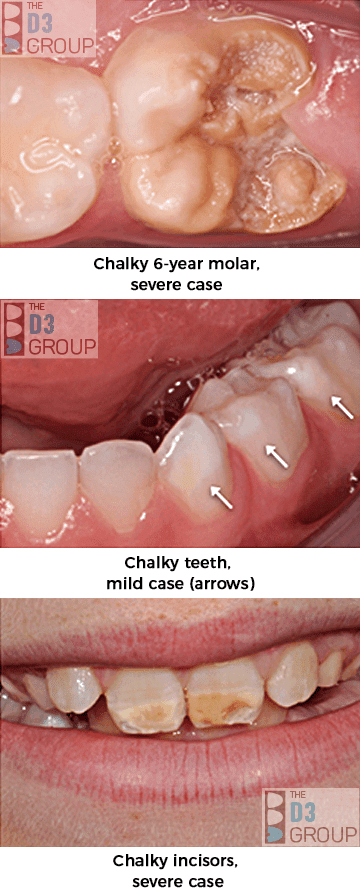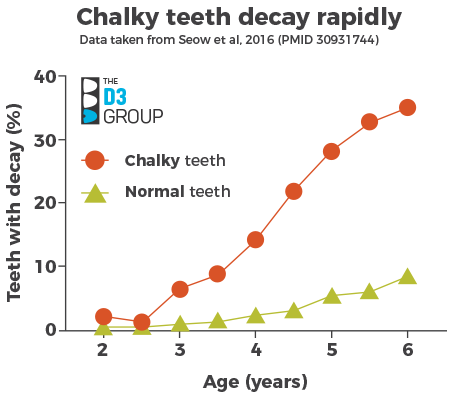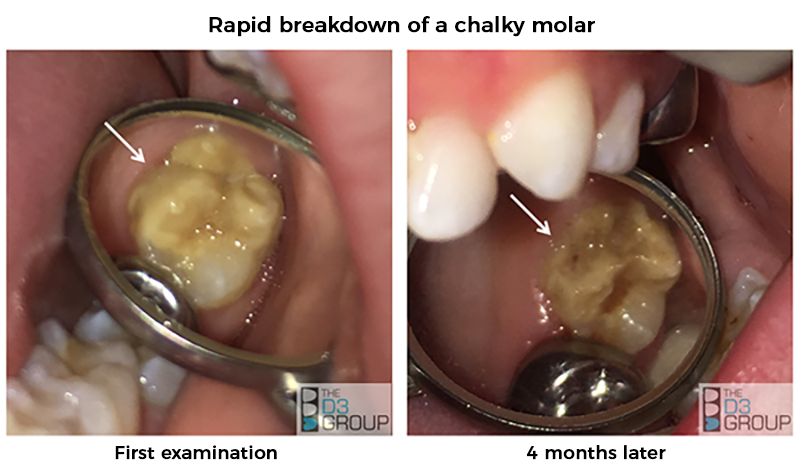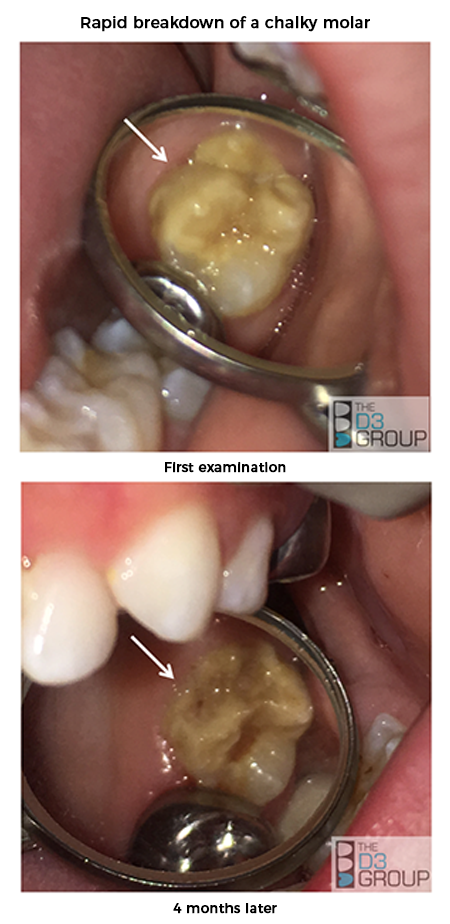MISSION: A WORLD FREE OF CHALKY TEETH
What are chalky teeth?
What does "chalky teeth" mean?
Simplistically, D3 Group scientists define "chalky teeth" as being different than normal (e.g. in colour and hardness) due to either a developmental problem or early damage from dental caries. However, being a colloquialism, "chalky teeth" means different things to different people. So what we can all agree on is that chalky teeth look different and are often troublesome. As world-leading science translators, The D3 Group has adopted "chalky teeth" as a public-friendly catch-all, meaning we're not at all fussy about how the term is used. That said, we think "chalky teeth" is a good description to use when beginning a scientifically accurate conversation about teeth that haven't developed properly, leading to enamel that isn't as hard and resistant to decay as normal (read more).
What do chalky teeth look like?
Chalky teeth can be identified where the enamel has an abnormal colour, either being whiter than normal or having shades of cream, yellow or brown. This discolouration is usually restricted to a small spot or bigger patch of chalky enamel, but the whole tooth surface may be affected in severer cases. Sometimes the chalky enamel appears dull and opaque and also crumbles easily (i.e. "chalky", in contrast to the shiny hard surface and translucency of normal enamel). Other times the surface enamel is shiny but irregular, with pits or grooves being visible from some angles.
What are chalky molars?
Chalky molars are the commonest type of chalky teeth and are of particular concern because they cause a lot of suffering and costs around the world. Technically, chalky molars are called "Molar Hypomineralisation", or "Molar Hypomin" for short ("hypomin" is pronounced "high-po-min"). Molars of course are back teeth and those most prone to this type of D3 are the "6-year molars" – otherwise known as the first "adult" or "permanent" molars. Other molars can also be affected including the "2-year molars" in toddlers and the "12-year molars". Sometimes in badly affected children their front teeth (incisors) can have this problem too, in which case you may hear the (now outdated) term "Molar-Incisor Hypomineralisation" or its abbreviation "MIH" used (read more).


Chalky teeth issues
Chalky teeth are commonly associated with toothache and an unusually rapid type of decay in molars – and sometimes the abnormal appearance of chalky front teeth is disturbing too. These issues often create need for complex dental treatment, which itself can be problematic in terms of access to appropriate expertise and allied costs. Additional burdens extend to the medical profession (emergency treatments, general anaesthetics) and tax payers. Such burdens are lifelong for many people with chalky teeth.
CHALKY TOOTH DECAY
A strong correlation exists between childhood tooth decay and the tooth types most prone to being chalky (i.e. 2-year molars, 6-year molars, 12-year molars). This reflects chalky enamel being less resistant to acids (from dental plaque and diet), and more prone to breakdown under chewing forces, than normal. Sensitivity of chalky teeth can make them difficult to keep clean, and the porosity of chalky enamel can give dental plaque extra places to hide. Consequently, decay can progress rapidly in mouths with chalky teeth. For example, an Australian study found that, from age 3 years, decay was over five-times more prevalent in chalky teeth than for normal baby teeth from the same mouths - see the graph below. And, as shown in the following pictures, severely-affected chalky molars can crumble badly in just a few weeks. It follows that everyone should be on alert for chalky teeth, starting from when each and every new tooth erupts into the mouth. However, in the longer term, there's good reason to hope that much suffering and expenditure will be saved once research enables chalky teeth to become preventable medically.



You can learn more about chalky teeth, Molar Hypomin and associated treatments at The D3 Group website.




